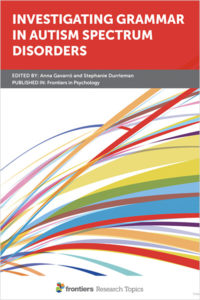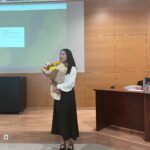4 abril, 2021
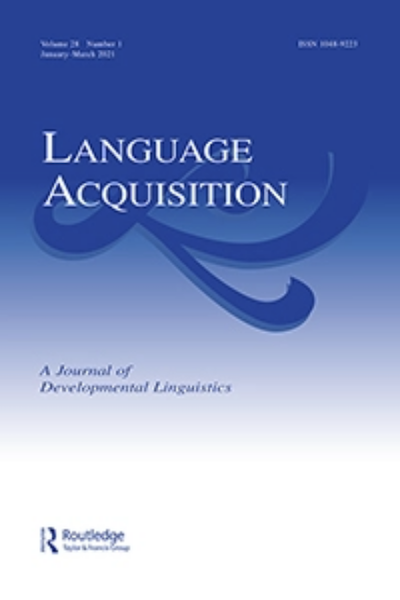
Autors:
Elena Pagliarini, Marta Andrada Reyes, Maria Teresa Guasti, Stephen Crain & Anna Gavarró
Títol:
Negative sentences with disjunction in child Catalan, Language Acquisition 2021Editorial: Routledge
Data de publicació: Gener del 2021
ISBN13: 1048-9223
Més informacióIn English, the sentence Mary didn’t eat pizza or sushi is assigned the neither interpretation (both disjuncts must be false). In Mandarin Chinese, the equivalent sentence is assigned the at least one interpretation (at least one disjunct must be false). The cross-linguistic variation in the interpretation of negative sentences with disjunction has been attributed to the Disjunction Parameter. On one value of this lexical parameter, disjunction is a Positive Polarity Item (+PPI). On the other value, disjunction is not a Positive Polarity Item (-PPI). According to the Semantic Subset Principle (SSP), all child language learners are predicted to initially assign the neither interpretation to negative disjunctive sentences, for reasons of language learnability. The present study investigates the interpretation of negative sentences with disjunction in Catalan. The findings confirm that disjunction is +PPI for adults; children show a bimodal distribution. For some children, disjunction is -PPI, as predicted by the SSP. However, some children adopt the adult +PPI value of the Disjunction Parameter. Children’s level of linguistic maturity, as measured by a sentence repetition task, was correlated with their judgments about negative sentences with disjunction such that children with lower scores tended to adopt the -PPI value. To explain the relatively early parameter resetting by some Catalan-speaking children, as compared to children acquiring other languages where disjunction is +PPI, we discuss the possible “blocking effect” of an alternative lexical expression in Catalan, which unambiguously conveys the neither interpretation.
27 gener, 2022
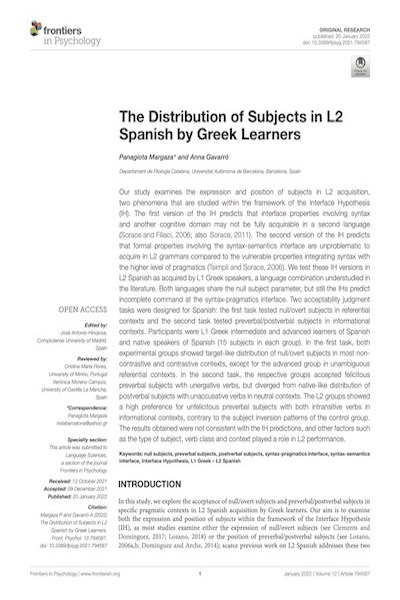
Autors:
Panagiota Margaza & Anna Gavarró
Títol:
The Distribution of Subjects in L2 Spanish by Greek LearnersEditorial: Frontiers in Psychology, Language Sciences
Col·lecció: Frontiers in PsychologyData de publicació: 20 gener 2022
Text completOur study examines the expression and position of subjects in L2 acquisition, two phenomena that are studied within the framework of the Interface Hypothesis (IH). The first version of the IH predicts that interface properties involving syntax and another cognitive domain may not be fully acquirable in a second language (Sorace and Filiaci, 2006; also Sorace, 2011). The second version of the IH predicts that formal properties involving the syntax-semantics interface are unproblematic to acquire in L2 grammars compared to the vulnerable properties integrating syntax with the higher level of pragmatics (Tsimpli and Sorace, 2006). We test these IH versions in L2 Spanish as acquired by L1 Greek speakers, a language combination understudied in the literature. Both languages share the null subject parameter, but still the IHs predict incomplete command at the syntax-pragmatics interface. Two acceptability judgment tasks were designed for Spanish: the first task tested null/overt subjects in referential contexts and the second task tested preverbal/postverbal subjects in informational contexts. Participants were L1 Greek intermediate and advanced learners of Spanish and native speakers of Spanish (15 subjects in each group). In the first task, both experimental groups showed target-like distribution of null/overt subjects in most non-contrastive and contrastive contexts, except for the advanced group in unambiguous referential contexts. In the second task, the respective groups accepted felicitous preverbal subjects with unergative verbs, but diverged from native-like distribution of postverbal subjects with unaccusative verbs in neutral contexts. The L2 groups showed a high preference for unfelicitous preverbal subjects with both intransitive verbs in informational contexts, contrary to the subject inversion patterns of the control group. The results obtained were not consistent with the IH predictions, and other factors such as the type of subject, verb class and context played a role in L2 performance.
Títols de la col·lecció / Also in this series:
25 abril, 2022
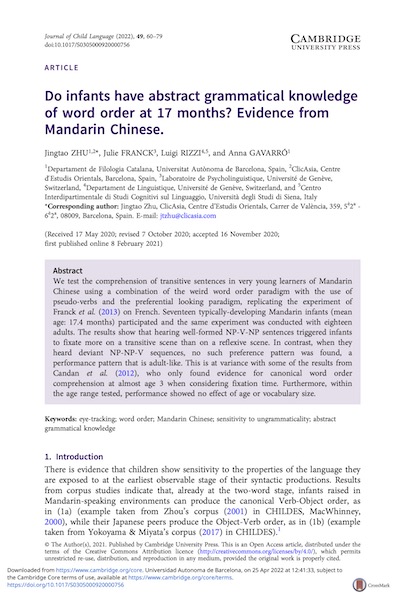
Autors:
Jingtao Zhu, Julie Franck, Luigi Rizzi & Anna Gavarró
Títol:
Do infants have abstract grammatical knowledge of word order at 17 months? Evidence from Mandarin ChineseEditorial: Journal of Child Language, 49(1), 60-79
Text completWe test the comprehension of transitive sentences in very young learners of Mandarin Chinese using a combination of the weird word order paradigm with the use of pseudo-verbs and the preferential looking paradigm, replicating the experiment of Franck et al. (2013) on French. Seventeen typically-developing Mandarin infants (mean age: 17.4 months) participated and the same experiment was conducted with eighteen adults. The results show that hearing well-formed NP-V-NP sentences triggered infants to fixate more on a transitive scene than on a reflexive scene. In contrast, when they heard deviant NP-NP-V sequences, no such preference pattern was found, a performance pattern that is adult-like. This is at variance with some of the results from Candan et al. (2012), who only found evidence for canonical word order comprehension at almost age 3 when considering fixation time. Furthermore, within the age range tested, performance showed no effect of age or vocabulary size.
17 octubre, 2022
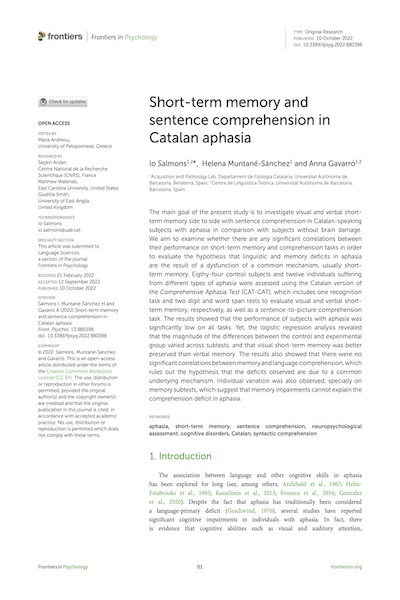
Autors:
Io Salmons, Helena Muntané-Sánchez & Anna Gavarró
Títol:
Short-term memory and sentence comprehension in Catalan aphasiaEditorial: Frontiers in Psychology 13:880398
Data de publicació: Octubre del 2022
Text completThe main goal of the present study is to investigate visual and verbal short-term memory side to side with sentence comprehension in Catalan-speaking subjects with aphasia in comparison with subjects without brain damage. We aim to examine whether there are any significant correlations between their performance on short-term memory and comprehension tasks in order to evaluate the hypothesis that linguistic and memory deficits in aphasia are the result of a dysfunction of a common mechanism, usually short-term memory. Eigthy-four control subjects and twelve individuals suffering from different types of aphasia were assessed using the Catalan version of the Comprehensive Aphasia Test (CAT-CAT), which includes one recognition task and two digit and word span tests to evaluate visual and verbal short-term memory, respectively, as well as a sentence-to-picture comprehension task. The results showed that the performance of subjects with aphasia was significantly low on all tasks. Yet, the logistic regression analysis revealed that the magnitude of the differences between the control and experimental group varied across subtests, and that visual short-term memory was better preserved than verbal memory. The results also showed that there were no significant correlations between memory and language comprehension, which rules out the hypothesis that the deficits observed are due to a common underlying mechanism. Individual variation was also observed, specially on memory subtests, which suggest that memory impairments cannot explain the comprehension deficit in aphasia.
31 desembre, 2022
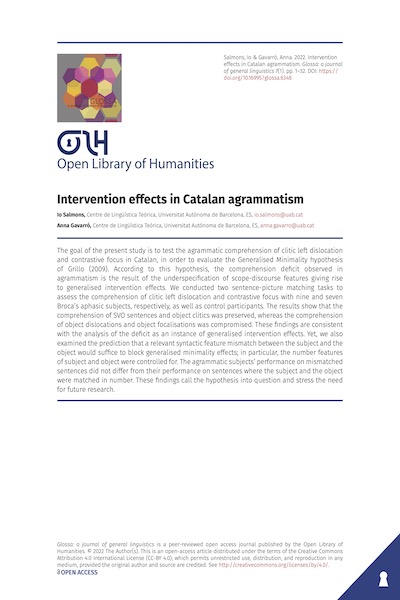
Autors:
Io Salmons & Anna Gavarró
Títol:
Intervention effects in Catalan agrammatismEditorial: Glossa: a journal of general linguistics (Open Library of Humanities)
Data de publicació: 31 de desembre del 2022
Text completThe goal of the present study is to test the agrammatic comprehension of clitic left dislocation and contrastive focus in Catalan, in order to evaluate the Generalised Minimality hypothesis of Grillo (2009). According to this hypothesis, the comprehension deficit observed in agrammatism is the result of the underspecification of scope-discourse features giving rise to generalised intervention effects. We conducted two sentence-picture matching tasks to assess the comprehension of clitic left dislocation and contrastive focus with nine and seven Broca’s aphasic subjects, respectively, as well as control participants. The results show that the comprehension of SVO sentences and object clitics was preserved, whereas the comprehension of object dislocations and object focalisations was compromised. These findings are consistent with the analysis of the deficit as an instance of generalised intervention effects. Yet, we also examined the prediction that a relevant syntactic feature mismatch between the subject and the object would suffice to block generalised minimality effects; in particular, the number features of subject and object were controlled for. The agrammatic subjects’ performance on mismatched sentences did not differ from their performance on sentences where the subject and the object were matched in number. These findings call the hypothesis into question and stress the need for future research.




